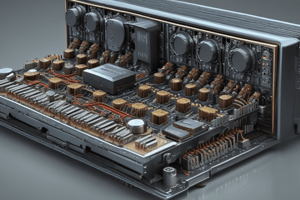Podcast
Questions and Answers
What are the fundamental components of Integrated Circuits (ICs)?
What are the fundamental components of Integrated Circuits (ICs)?
- Transistors, resistors, capacitors, and diodes (correct)
- Diodes, inductors, transistors, and capacitors
- Amplifiers, diodes, inductors, and resistors
- Inductors, resistors, amplifiers, and transistors
What is the main function of resistors in an Integrated Circuit (IC)?
What is the main function of resistors in an Integrated Circuit (IC)?
- Store and release electrical energy
- Control voltage and current levels
- Limit the flow of electric current (correct)
- Act as switches within the circuit
Which component in an IC is used for filtering, coupling, and energy storage?
Which component in an IC is used for filtering, coupling, and energy storage?
- Diodes
- Transistors
- Capacitors (correct)
- Resistors
What is the primary function of transistors in Integrated Circuits?
What is the primary function of transistors in Integrated Circuits?
How are Integrated Circuits (ICs) different from discrete electronic components?
How are Integrated Circuits (ICs) different from discrete electronic components?
Why are capacitors used in Integrated Circuits?
Why are capacitors used in Integrated Circuits?
What is the primary role of diodes in electronic circuits?
What is the primary role of diodes in electronic circuits?
Which type of IC operates with discrete signals representing binary data?
Which type of IC operates with discrete signals representing binary data?
What is the key advantage of integrated circuits (ICs) related to miniaturization?
What is the key advantage of integrated circuits (ICs) related to miniaturization?
Which characteristic best describes operational amplifiers (Op-amps)?
Which characteristic best describes operational amplifiers (Op-amps)?
What is the function of feedback components in operational amplifiers?
What is the function of feedback components in operational amplifiers?
Which type of integrated circuit combines analog and digital functions?
Which type of integrated circuit combines analog and digital functions?
What is a common application of operational amplifiers?
What is a common application of operational amplifiers?
Which feature of operational amplifiers helps minimize loading effects on preceding circuit stages?
Which feature of operational amplifiers helps minimize loading effects on preceding circuit stages?
What is the purpose of using external components in closed-loop op-amp configurations?
What is the purpose of using external components in closed-loop op-amp configurations?
Which of the following is a common application of op-amps?
Which of the following is a common application of op-amps?
What is the typical bandwidth of the Op Amp IC 741?
What is the typical bandwidth of the Op Amp IC 741?
Which pin in the Op Amp IC 741 serves as the non-inverting input?
Which pin in the Op Amp IC 741 serves as the non-inverting input?
What is the typical output voltage swing range for the Op Amp IC 741?
What is the typical output voltage swing range for the Op Amp IC 741?
What is the function of Pin 1 (Offset Null Pin) in the Op Amp IC 741?
What is the function of Pin 1 (Offset Null Pin) in the Op Amp IC 741?
Which parameter reflects an op-amp's ability to reject common-mode signals?
Which parameter reflects an op-amp's ability to reject common-mode signals?
What is the primary role of op-amps in active filter circuits?
What is the primary role of op-amps in active filter circuits?
Ext{In which configuration does an op-amp operate without feedback?}
Ext{In which configuration does an op-amp operate without feedback?}
How is an inverting amplifier configuration created with an operational amplifier?
How is an inverting amplifier configuration created with an operational amplifier?
Which amplifier configuration provides a voltage gain greater than one and is commonly used in audio amplifiers and voltage followers?
Which amplifier configuration provides a voltage gain greater than one and is commonly used in audio amplifiers and voltage followers?
What is one of the applications of Op Amp IC 741 mentioned in the text?
What is one of the applications of Op Amp IC 741 mentioned in the text?
How is the Common-Mode Rejection Ratio (CMRR) of an op-amp measured?
How is the Common-Mode Rejection Ratio (CMRR) of an op-amp measured?
What parameter is determined by applying varying common-mode voltage to an op-amp and finding the range where it operates within specifications?
What parameter is determined by applying varying common-mode voltage to an op-amp and finding the range where it operates within specifications?
How is Input Offset Current (Ios) of an operational amplifier calculated?
How is Input Offset Current (Ios) of an operational amplifier calculated?
What does Supply Voltage Rejection Ratio (SVRR) of an op-amp measure?
What does Supply Voltage Rejection Ratio (SVRR) of an op-amp measure?
How can Slew Rate (SR) of an op-amp be determined?
How can Slew Rate (SR) of an op-amp be determined?
What can be achieved using an op-amp as a comparator?
What can be achieved using an op-amp as a comparator?
How is Input Bias Current (IB) measured for an op-amp?
How is Input Bias Current (IB) measured for an op-amp?
What does Gain-Bandwidth Product (GBW) measure for an op-amp?
What does Gain-Bandwidth Product (GBW) measure for an op-amp?
What is the primary function of capacitors in an Integrated Circuit (IC)?
What is the primary function of capacitors in an Integrated Circuit (IC)?
Which component in an Integrated Circuit (IC) is responsible for controlling the flow of electrical signals within the circuit?
Which component in an Integrated Circuit (IC) is responsible for controlling the flow of electrical signals within the circuit?
What role do resistors play in an Integrated Circuit (IC)?
What role do resistors play in an Integrated Circuit (IC)?
What is the purpose of transistors in an Integrated Circuit (IC)?
What is the purpose of transistors in an Integrated Circuit (IC)?
Which component in an Integrated Circuit (IC) limits the flow of electric current?
Which component in an Integrated Circuit (IC) limits the flow of electric current?
In an Integrated Circuit (IC), what function do diodes primarily serve?
In an Integrated Circuit (IC), what function do diodes primarily serve?
What is the primary function of external components in closed-loop op-amp configurations?
What is the primary function of external components in closed-loop op-amp configurations?
Which parameter of the Op Amp IC 741 indicates the voltage difference between its input terminals when the output is zero?
Which parameter of the Op Amp IC 741 indicates the voltage difference between its input terminals when the output is zero?
What is the typical bandwidth range of the IC 741 Op Amp for optimal performance?
What is the typical bandwidth range of the IC 741 Op Amp for optimal performance?
In what configuration does an op-amp operate without any feedback?
In what configuration does an op-amp operate without any feedback?
What is a key feature of op-amps that allows them to drive loads without significantly affecting the output voltage?
What is a key feature of op-amps that allows them to drive loads without significantly affecting the output voltage?
Which pin in the Op Amp IC 741 serves as the Inverting Input (-) Pin?
Which pin in the Op Amp IC 741 serves as the Inverting Input (-) Pin?
What does the Common-Mode Rejection Ratio (CMRR) of an op-amp reflect?
What does the Common-Mode Rejection Ratio (CMRR) of an op-amp reflect?
Which parameter of Op Amp IC 741 can handle changes in output voltage up to 0.5 V per microsecond?
Which parameter of Op Amp IC 741 can handle changes in output voltage up to 0.5 V per microsecond?
'NC' pin in the Op Amp IC 741 stands for:
'NC' pin in the Op Amp IC 741 stands for:
What is the primary function of diodes in electronic circuits?
What is the primary function of diodes in electronic circuits?
Which characteristic best describes operational amplifiers (Op-amps)?
Which characteristic best describes operational amplifiers (Op-amps)?
What is the key advantage of integrated circuits (ICs) related to miniaturization?
What is the key advantage of integrated circuits (ICs) related to miniaturization?
Which type of IC combines both analog and digital functions?
Which type of IC combines both analog and digital functions?
What is the primary role of transistors in Integrated Circuits?
What is the primary role of transistors in Integrated Circuits?
How are Op-amps different from traditional discrete circuits in terms of reliability?
How are Op-amps different from traditional discrete circuits in terms of reliability?
What is the typical application of Op Amp IC 741 mentioned in the text?
What is the typical application of Op Amp IC 741 mentioned in the text?
Which parameter reflects an op-amp's ability to reject common-mode signals?
Which parameter reflects an op-amp's ability to reject common-mode signals?
What can be achieved using an op-amp as a comparator?
What can be achieved using an op-amp as a comparator?
How is Input Offset Current (Ios) of an operational amplifier calculated?
How is Input Offset Current (Ios) of an operational amplifier calculated?
How can the Input Offset Voltage (Vos) of an operational amplifier be calculated?
How can the Input Offset Voltage (Vos) of an operational amplifier be calculated?
What is the primary application of op-amp IC 741 in signal processing?
What is the primary application of op-amp IC 741 in signal processing?
How is the Common-Mode Rejection Ratio (CMRR) of an op-amp calculated?
How is the Common-Mode Rejection Ratio (CMRR) of an op-amp calculated?
What is the purpose of applying feedback in operational amplifiers?
What is the purpose of applying feedback in operational amplifiers?
How is the Gain-Bandwidth Product (GBW) of an op-amp determined?
How is the Gain-Bandwidth Product (GBW) of an op-amp determined?
What parameter describes an op-amp's ability to maintain a stable output voltage with varying input voltage?
What parameter describes an op-amp's ability to maintain a stable output voltage with varying input voltage?
In which operational amplifier configuration is the input signal connected to the non-inverting input?
In which operational amplifier configuration is the input signal connected to the non-inverting input?
If we want to measure Common-Mode Rejection Ratio (CMRR) of an op-amp, how should we apply inputs?
If we want to measure Common-Mode Rejection Ratio (CMRR) of an op-amp, how should we apply inputs?
Which parameter indicates an op-amp's capability to reject unwanted signals that are common to both inputs?
Which parameter indicates an op-amp's capability to reject unwanted signals that are common to both inputs?
What is a key advantage of using integrated circuits like Op Amp IC 741 for signal amplification compared to discrete components?
What is a key advantage of using integrated circuits like Op Amp IC 741 for signal amplification compared to discrete components?
Flashcards are hidden until you start studying
Study Notes
Operational Amplifiers (Op-Amps)
- A voltage amplifying device designed to be used with components like capacitors and resistors, between its input and output terminals.
- Op-amps are essentially a core part of analog devices.
Types of Op-Amps
- Inverting Amplifier: connects input signal to the inverting input (Pin 2) and provides feedback from the output to the inverting input.
- Non-Inverting Amplifier: connects input signal to the non-inverting input (Pin 3) and provides feedback from the output to the inverting input.
Applications of Op-Amps
- Signal Amplification
- Voltage Regulation
- Filters
- Oscillators
- Mathematical Operations (add, subtract, integration, and differentiation)
Characteristics of Op-Amps
- Differential Inputs: two input terminals, labeled as the inverting (-) and non-inverting (+) inputs.
- High Input Impedance: op-amps draw very little current from the input sources.
- Low Output Impedance: allows op-amps to drive loads without significantly affecting the output voltage.
Open-Loop and Closed-Loop Operation
- Open-Loop Configuration: op-amp operates without any feedback.
- Closed-Loop Configuration: external components (resistors, capacitors, etc.) are connected to the op-amp to control its behavior.
Op-Amp IC 741
- Features: high voltage amplification capability, low-frequency applications, high input impedance, and low output impedance.
- Specifications: dual power supplies, operating temperature range, input offset voltage, common-mode rejection ratio, and output voltage swing.
- Pin Configuration: 8-pin DIP or surface-mount package.
Measurement of Op-Amp Parameters
- Input Offset Voltage (Vos): measure the output voltage with equal and opposite input voltages.
- Input Offset Current (Ios): measure the current flowing into or out of the inverting and non-inverting inputs.
- Common-Mode Rejection Ratio (CMRR): measure the output voltage with common-mode input voltage and with differential input voltage.
Integrated Circuits (ICs)
- Definition: a miniaturized electronic circuit that consists of semiconductor devices and passive components fabricated on a small piece of semiconductor material.
- Components of ICs: transistors, resistors, capacitors, and diodes.
- Types of ICs: Analog ICs, Digital ICs, and Mixed-Signal ICs.
- Advantages of ICs: miniaturization, reliability, power efficiency, and cost-effectiveness.### Operational Amplifiers (Op-Amps)
- The output impedance of an op-amp is low, allowing it to drive loads without significantly affecting the output voltage.
- Op-amps have a very high open-loop voltage gain, often exceeding 100,000.
- In most practical applications, op-amps are used in closed-loop configurations where the gain is controlled by external components.
Applications of Op-Amps
- Signal Amplification: Op-amps are used to amplify weak signals, making them suitable for a variety of applications such as audio amplifiers, signal conditioners, and instrumentation amplifiers.
- Voltage Regulation: Op-amps are used in voltage regulators to maintain a stable output voltage.
- Filters: Op-amps are employed in active filter circuits for signal processing and frequency shaping.
- Oscillators: Op-amps can be configured to generate oscillating waveforms, making them useful in signal generators and waveform generators.
- Mathematical Operations: Op-amps are used in circuits performing mathematical operations such as addition, subtraction, integration, and differentiation.
Features of Op Amp IC 741
- High Gain: The IC 741 has a high voltage amplification capability, typically around 200,000.
- Bandwidth: The IC 741 works well for low-frequency applications, with a bandwidth of 1 to 1.5 MHz.
- Impedance: It has a high input impedance (around 2 MΩ) and a low output impedance (about 75 Ω).
- Slew Rate: The IC 741 can handle changes in output voltage up to 0.5 V per microsecond.
- Power Supply: The IC 741 needs dual power supplies, typically between ±5V and ±18V, for proper operation.
- Offset Voltage: The IC 741 has an offset voltage of approximately 2 mV.
Specifications of Op Amp IC 741
- Package Type: The IC 741 is available in an 8-pin DIP or surface-mount package.
- Operating Temperature Range: The IC 741 can operate between -55°C and +125°C.
- Input Offset Current: It has a low input offset current of around 20 nA.
- Common-Mode Rejection Ratio (CMRR): The CMRR of the IC 741 is typically 90 dB.
- Input Bias Current: The IC 741 has an input bias current of around 80 nA.
- Output Voltage Swing: The maximum output voltage swing for the IC 741 is typically ±12V.
Pin Configuration of Op Amp IC 741
- Pin 1: Offset Null
- Pin 2: Inverting Input (-)
- Pin 3: Non-inverting Input (+)
- Pin 4: V-
- Pin 5: Output
- Pin 6: V+
- Pin 7: NC (No Connection)
- Pin 8: N/A (Not Connected)
Working and Internal Schematics of Op-Amp IC 741
- Open Loop Configuration: The Op Amp operates without feedback, where the output depends solely on the input voltage.
- Inverting Operational Amplifier: Provides a voltage gain dependent on the ratio of the feedback resistor to the input resistor.
- Non-inverting Operational Amplifier: Provides a voltage gain greater than one and is commonly used in audio amplifiers and voltage followers.
Applications of Op Amp IC 741
- Signal Amplification: The IC 741 is used to amplify weak signals from sensors like thermocouples, microphones, and strain gauges.
- Active Filters: It can be used to design active filters for signal conditioning and noise reduction.
- Voltage Regulators: The IC 741 can stabilize and regulate power supplies, ensuring a constant output voltage even with varying input voltage.
- Oscillators: It is used in oscillator circuits to generate continuous waveforms, such as sine waves, square waves, and triangular waves.
- Comparators: The IC 741 can be employed as a comparator to compare input voltages and produce a digital output.
Measurement of Op-Amp Parameters
- Input Offset Voltage (Vos): Measured by applying equal and opposite input voltages and measuring the resulting output voltage.
- Input Offset Current (Ios): Measured by measuring the current flowing into or out of the inverting and non-inverting inputs with both inputs grounded.
- Common-Mode Rejection Ratio (CMRR): Measured by applying a common-mode input voltage and measuring the output voltage.
- Input Bias Current (IB): Measured by measuring the current flowing into or out of one of the input terminals with the other input grounded.
- Slew Rate (SR): Measured by applying a step input signal and measuring the time it takes for the output to change from 10% to 90% of its final value.
- Gain-Bandwidth Product (GBW): Measured by measuring the open-loop gain at different frequencies and plotting the product of gain and frequency.
Studying That Suits You
Use AI to generate personalized quizzes and flashcards to suit your learning preferences.





